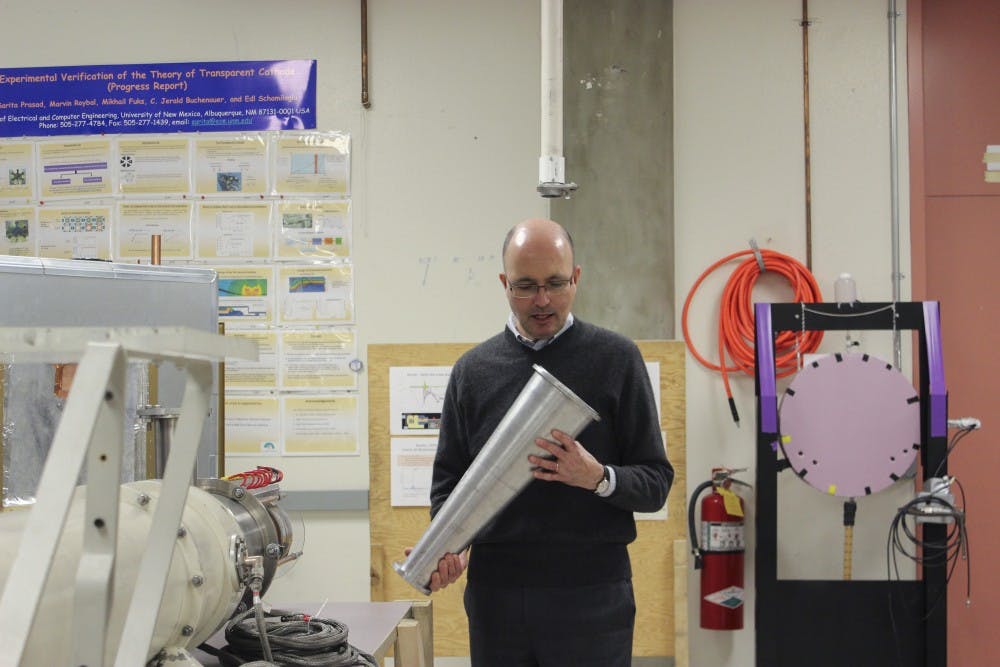Edl Schamiloglu, a professor of electrical and computer engineering, was recognized for his contributions to the field of pulsed power and was awarded the 2015 IEEE Nuclear and Plasma Society’s Pulsed Power Science and Technology Committee’s Peter Haas Award.
According to the NPSS website, The Peter Haas Award “recognizes individuals whose efforts, over an extended period, have greatly benefited the pulsed power field through the development of important applications or areas of activity including research, education and information exchange.”
The award is presented once every two years and includes a commendation, plaque and $3,000, the website states. The award bears the name of the late Peter Haas, who was recognized at the 2nd Pulse Power Conference in 1979.
“This one in particular, I’m quite honored to receive because this award is really for an individual who has basically built a team together, led a group and has contributed to the field over an extended period of time,” Schamiloglu said. “I had nothing when I came here — when I came they gave me a used PC and that was it. So I was able to build up an internationally recognized program basically with our own sheer willpower and hard work over the years.”
Schamiloglu was raised in The Bronx, New York and finished his doctorate at Cornell University, he said. He said he was supposed to head to Los Alamos to work on a fusion project, but plans changed when then-President Reagan canceled the Alternate Concepts Fusion Program.
Stan Humphries, a professor at UNM who Schamiloglu knew at the time, invited him to come to UNM, Schamiloglu said. He started at UNM as an assistant professor in January 1988 and has remained with the college ever since.
There are numerous rewards to a career in his chosen field, but Schamiloglu said he is very thankful for the opportunity to teach and travel, along with the people he has met in the process.
“Having had all the students that I’ve worked with, that’s always been a pleasure. But also, it’s a very international community and I’ve had lots of interactions with scientists from all over the world,” he said.
In April, Schamiloglu took over directorship of the COSMIAC Center after previous director, Professor Christos Christodoulou, became associate dean for research in The School of Engineering.
The COSMIAC Center is a research institution under the School of Engineering working on aerospace and defense projects, and as Schamiloglu put it, “it’s a very entrepreneurial center.”
When the center started it was focused and aligned with the type of research the Space Vehicles Directorate does at the Air Force Research Lab, he said. As time has gone on, COSMIAC has gained interest in performing research on space systems.
Get content from The Daily Lobo delivered to your inbox
One such example, Schamiloglu said, is COSMIAC’s involvement in a CubeSat program in which students and faculty build cube satellites that are eventually launched by NASA.
Schamiloglu has also run his own laboratory out of UNM for 25 years now, he said. The work is expensive, due largely to the hardware necessary to run experiments, and requires large amounts of outside monetary support, he said.
“In the end, it is a matter of competing with other universities for funding,” he said. “You need a vigorous source of funding. I think what I’ve been successful at over the years is not only successfully bringing money in, which is a good start, but I think once you have the grant money then you need to follow through and deliver on the research. I’ve been fortunate. I’ve had outstanding graduate students, post-docs and research faculty. The key is innovation and I think we’ve been very good at innovation. I think that our sponsors have been very happy with us, over the years, and value our contributions.”
The hard work has paid off dividends, as Schamiloglu has raised around $22 million in his 25 years at UNM as an individual professor, he said. The Office of Naval Research and Air Force Office of Scientific Research are two consistent basic funding agencies that support his work at UNM.
“The work that we do in my laboratory on pulsed power, high-energy density, plasmas, it’s not performed in very many universities in the country. In fact, right now there are only a handful of universities,” Schamiloglu said. “We happen to have an internationally recognized program in this area. My laboratory and this program is one of the, I think, gems of science and engineering research at the University of New Mexico.”
Last fall, Schamiloglu became the principal investigator of a six-year, $6 million grant for the AFRL/AFOSR Center of Excellence on the Science of Electronics in Extreme Electromagnetic Environments, he said. For this grant, Schamiloglu and UNM has partnered with affiliates at The University of Maryland and he said he looks forward to collaborating on the project.
Schamiloglu said he encourages any students who are pursuing a field to not give up and be patient for the rewards, a lesson he himself learned in his days as a graduate student.
“A lot of times you come into the lab, you work all day and you have really nothing to show for it. You realize it was all those hours that you put in day in and day out, that by themselves you might not have much to show, but taken in sum really gives you the finished product,” he said. “I’ve been at UNM since 1988 and I’m receiving accolades now — and I think it just pays off for all those years.”
Matthew Reisen is a staff reporter at the Daily Lobo. He can be contacted at news@dailylobo.com or on Twitter @DailyLobo.






